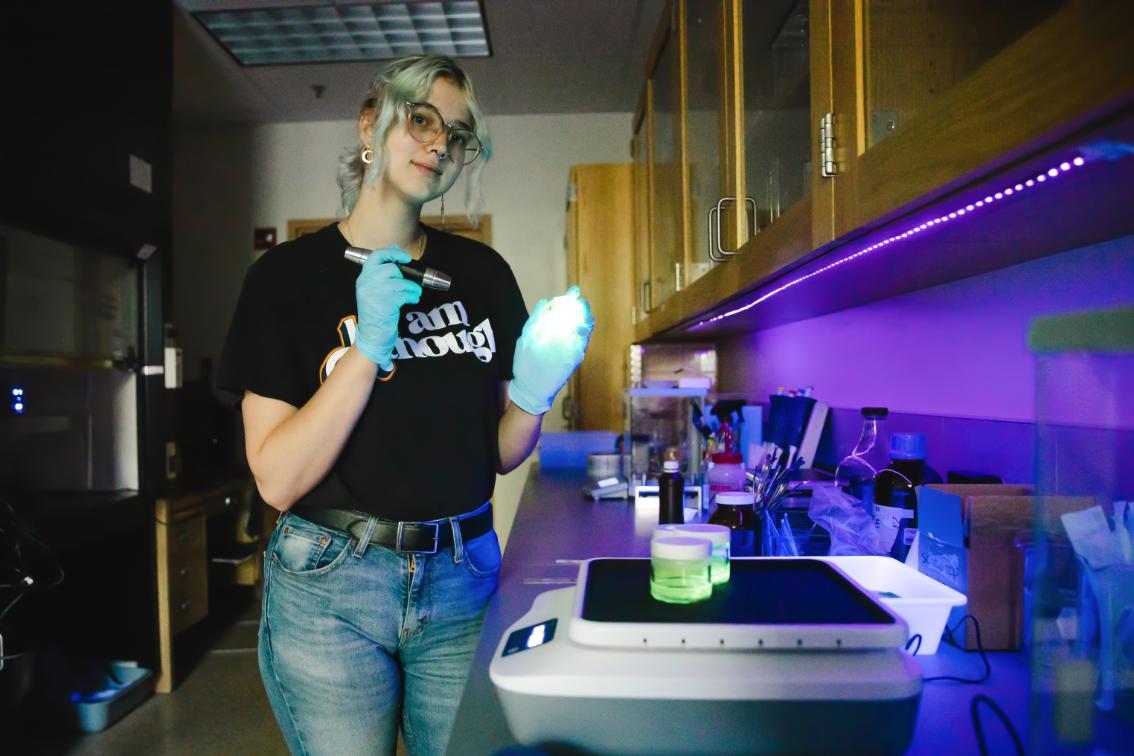

Mira Strong ’28 did something pretty unique to kick off her summer while working with Dr. Tyler St. Clair on a PRISM research project. The chemistry major got the opportunity to build an electrospinner, a device that uses electrical force to produce small fibers from a polymer solution.
“Wiring that [electrospinner] made me feel pretty cool, because I don’t think many other people in this building would have been able to do that,” said Strong, a rising sophomore who also has a concentration in secondary education.
The story of how these molecules are arranging is supported by each type of new data that we’re collecting.
Mira Strong ’28 Tweet This
Think of polymers like a necklace chain. When a polymer is electrospun, it’s like a chain being stretched. It’s pretty easy to assume that the chain will arrange itself into a straight line when stretched. However, when charms or pendants are added to the chain, the stretched necklace might arrange itself in a more complicated, less predictable way. Additives, which are chemicals embedded into the polymer matrix, are like charms on a necklace chain. Strong and St. Clair observed the behavior of polymers with additives when they are electrospun during PRISM (Perspectives on Research in Science and Mathematics), Longwood’s eight-week intensive summer program where students collaborate and conduct research one-on-one with faculty members.
“We’re actually trying to understand some fundamental things about how molecules are arranging,” said St. Clair, associate professor of science education. “The story of how these molecules are arranging is supported by each type of new data that we’re collecting.”
We caught up with Strong to learn more about her experience as a PRISM researcher.
Tell us about your project.
We’re looking into polymers, specifically particular plastic polymers, and electrospinning them, which is a fiber production method that uses electrical force. They’re forced through an electric field and get stretched out infinitely thin so that they have a super high surface area. We’re looking at what happens to additives in our particular polymer, PLA, which people use for 3D printing. Currently we’re looking at coumarin derivatives, which are all very fluorescent—besides the parent compound. We’ve noticed a blue shift in our electro-spun versus our control films, which suggests that there’s a lot of energy being trapped in the intermolecular forces. That means they’re probably in orientations they really don’t want to be in. We’re trying to figure out exactly what those orientations are and how it’s working.
What does a typical day look like for you in the lab?
I come in, we talk about our plans for the day over a cup of coffee, and we make our schedule. We head down to either the lab to start prepping things, or we head down to the conference room to read up on the things that we’re going to do later in the day. After lunch we finish up whatever we were doing in the morning and then talk about what we plan on doing the next day so that we can get a head start on our planning the next morning.
It’s been good to apply something tangible to the knowledge that I already had.
Mira Strong ’28 Tweet This
What has been your favorite part of your research so far?
Mostly just getting to do research. A lot of what you learn in science is conceptual, and you’re supposed to be able to visualize how all of these things work. But it’s great to be able to be hands on with it and getting to use the electrospinner. We’re watching as these fibers get drawn out and we create these fun little mats. You can shine a UV light on them and they glow! It’s been good to apply something tangible to the knowledge that I already had.
What skills have you acquired over the summer?
Problem solving! Things go wrong and we keep having to ask ourselves, “Why did that happen?” Learning how to assess and manage the situation is one of the big things I’ve taken away from this research. Today we spent the entire day electrospinning and casting films for an additive we realized wouldn’t even fluoresce. We just kind of had to take 20 seconds and breathe it out. Then we realized that we found some pretty cool things from our data anyway. So even mistakes are learning tools. And learning how to deal with failure, or something not going as expected, is absolutely an applicable skill for every part of your life.
We’re all here for the same reason—trying to do fun science things—and it’s fostered a really nice environment. I mean, all of us pretty much know each other by name and what we’re doing.
Mira Strong ’28 Tweet This
What has been your favorite part of the PRISM program?
I really like the little community that we have. We’re all here for the same reason—trying to do fun science things—and it’s fostered a really nice environment. I mean, all of us pretty much know each other by name and what we’re doing.
Would you recommend PRISM to other Longwood students?
Oh, absolutely. It’s been very educational. Also, some people might not realize that students receive a stipend and free room and board as part of the program. So you are paid for the time that you’re here. I would absolutely 100 percent recommend it to anybody.
